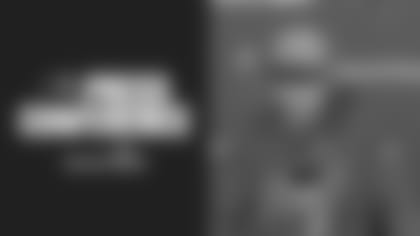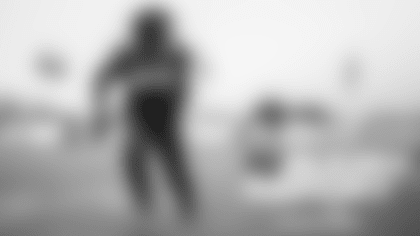The Answer Man doesn't know whether to feel relieved or disappointed.
Last week, concerned that my readers were become a bit too fawning in order to get their questions answered, I invited question submitters to treat me rudely instead. Take me down a notch – creatively and non-profanely – and you might improve your chances of landing a question in the next column.
Well, turns out you're an awfully polite bunch (or perhaps many of you just didn't read far enough into that last column to see my challenge). For awhile, I thought that fear of my superhuman capabilities kept some of you from risking my ire. After all, I do wear a cape, and the arc of electricity over my head suggests some mysterious power. Then I remembered that I've never been witnessed doing anything more daredevil than standing on the top rung of a ladder to replace a ceiling tile at One Buc Place.
But, for whatever reason, I took very little abuse in the ol' e-mailbag this week, despite the open invitation. So…uh…thank you, I guess.
One reader who had his question answered last week – the Answer Man became his personal attack dog against a columnist who had the temerity to suggest the Bucs had a weak defense – wrote back to ask about the Answer Man's origins. I'm sorry, I'm not ready to reveal that just yet. The government could be reading, and I don't want to end up in Area 51. Maybe someday soon I'll relate my fascinating back story.
For now, however, I'm just going to do what I do best – answer your questions. Read on!
**
- Carl Cover of Des Plaines, Illinois asks:
Hey Answer Nerd. Perhaps you could check that tome of rules and provide a clarification. I was watching a college football game where a running back fumbled while struggling a first down. The fumble clearly occurred before he reached the first down marker. The ball, however, rolled forward 3-4 yards, passed the first down marker and then slid out of bounds. The line judge placed the ball where it went out of bounds and the offense was awarded a first down. I believe that the NFL would have placed the ball at the point of the fumble and the offense would not have been awarded a first down. Is this correct? Would this be true if the ball rolls backwards instead of forward (forward progress rule)?
Answer Man: See – Answer Nerd. That's about as rough as it got. I get a harder time from the Answerlings on a daily basis.
On the other hand, Carl gives me some indirect abuse by sending me back into the dreaded NFL Rulebook. This one's fairly easy, though, and the Answer Man is getting more adept every day at finding what he needs in that soul-sucking piece of work.
For instance, I located Rule 7, Section 5, Article 6 rather quickly while working up Carl's answer. Here it is in plain English, before we get into Rulebook Speak: If the ball was fumbled forward out of bounds, it will come back to the spot of the fumble. If it is fumbled backward out of bounds, it will be spotted where it went out of bounds.
Actually, in this case, that's pretty much what the rulebook says, so maybe the Answer Man is getting a bit too touchy about that 'tome.' Here's the excerpt:
Rule 7, Section 5, Article 6: A fumble by the offensive team cannot result in an advance by that team if the ball is not recovered in the field of play or end zone. (a) A fumble that goes forward and out of bounds is to return to that team at the spot of the fumble. (b) A fumble in the field of play that goes backward and out of bounds belongs to the offense at the out-of-bounds spot.
By the way, another sub-article a few lines down makes it clear that this rule holds even in the event of a safety. That is, if a runner were to fumble while in his own end zone, and the ball went forward out of the end zone and then out of bounds, it would be a safety.
Answer Man doesn't have as much knowledge about college football, nor do I own an NCAA rulebook. However, if Carl's above account is accurate, I'm of the opinion that the NFL has the better rule for this situation.
Still doesn't mean I like the rulebook, though.
**
- David B. Neider of Yuma, Arizona asks:
**Answerman, my question is a two parter.
Part 1: I know that picking by a receiver is illegal, but I noticed a player using a ref as a pick. He didn't get called for it, and it was pretty easy to spot on the replay. He was so close to that the ref had to duck his head to avoid being hit by the football. Is this legal?
Part 2: Is a forward pass still live if it hits an official?**
Answer Man: I feel like Michael Corleone. Just when I thought that I was out of that book, they pull me back in.
Okay, David, this was an obvious call to start flipping through the rulebook again, but the office coffeemaker only had decaf when I started work on this question and I just wasn't sure I could keep my head off the desk. So I took a different approach.
I wandered next door in search of the first coach I could find. I found two, and they graciously stopped watching film for a few minutes to answer my – I mean, your – questions. The two helpers were Running Backs Coach Art Valero and Assistant Offensive Line Coach Jim Pyne. They answered your questions in reverse order.
First, yes, a pass is still live if it hits an official. Both Valero and Pyne could remember specific incidents of passes glancing off an official or taking off his hat. Obviously, you'd have to catch a pass that hit off an official before it hit the ground to avoid an incompletion, but if you did, you're free to mosey on down the field.
As for the pick play, I think the best way we (the coaches and I, that is) can answer that, David, is to ask you this question: On a pick that draws a flag, who gets the penalty?
It's not the pass-catcher, the one who benefits from the pick. It's the other player, the one who sets the pick. So if a receiver runs in proximity to an official and finds a way to use his presence to his advantage by picking off a defender, who's going to get the penalty? The official isn't going to flag himself, and the receiver didn't pick anybody himself.
Officials are live parts of the action, but they do they're best to stay out of the way. That's why you don't see this ploy actually come into play very often.
Back to the live ball off the official. Something told me you won't be satisfied until you see it in black-and-white, straight out of the rulebook. So when I got back to my desk, I did the due diligence. For your reading pleasure, here's Rule 7, Section 4, Article 5:
The ball is not dead because of touching an official who is inbounds or because of a signal by an official other than a whistle.
**
- Wes Locke of Umatilla, Florida asks:
I consider myself a fairly knowledgeable football fan but the other day my son asked me a question and I couldn't answer him. Can you imagine the trauma? My first thought was, "Oh no! I'm a failure in my son's eyes!" My second thought was, "Wait, the Answer Man can save me!" So, I told my son to look it up and I'd tell him whether or not he was right. (Stalling!) Now I need to get the answer myself! Where did the names Quarter Back, Half Back, and Full Back come from? Please help me save my reputation with my son Answer Man!
Answer Man: That is serious, Wes. I finally feel like I'm doing some serious superhero work here.
Well, you sent this question in a few days ago, and young Mr. Locke might be getting pretty suspicious by now, so let's get right to the answer.
Have you ever seen one of those 'illegal formation' penalties where the offense is flagged for not having enough men on the line of scrimmage? Seven of the 11 players on offense have to be on the line. That usually consists of the five offensive lineman, the tight end and one of the two receivers.
The remaining four players are thus set up somewhere behind the line. In the early days, those players were mostly in the backfield in some running formation. They were named for how far they were behind the players on the line. The man farthest behind the line was fully back, so he was called the fullback. The runner in front of him was thought of as being halfway between the fullback and the line, so he (or they) got the term halfback.
Obviously, the player who took the snap from right under the center was between the halfback and the line, so he was termed the quarterback. Those terms persist today.
However, it's interesting that the roles of the fullback and the halfback seem to have switched over time. The player we now call fullback usually lines up between the quarterback and the halfback. Perhaps that's why the more generic term of running back is most often used for the man who is likely to take the handoff.
Hope that helps, Wes. Oh, and I hope you haven't taught your son how to access the internet yet. Your cover might already be blown.
**
- Lisa Nugent of St. Petersburg, Florida asks:
**Hey, Answer Man!
Who do the players talk to on the phone in between plays? What are they talking about?**
Answer Man: Hey, Lisa!
Good news! Those players just saved a bunch of money on their car insurance!
Juuuuuust kidding. Those players are talking to their specific position coaches, and they're probably getting pointers on some aspect of their performance to work on. In some cases, they're getting a quick bit of praise after a particularly good play or string of plays.
On game day, a team's coaching staff splits into two groups, with roughly half staying with the head coach on the sideline and the other half going upstairs to a booth near the press box. The latter group gets a different, more complete view of the game and uses it to track plays and pick up on the opponent's strategies. The head coach is in constant contact with the men upstairs through his headphones.
The coaches' booth also has a dedicated line to a phone on a table set up by the players' benches. The players aren't wearing headsets, obviously, so if a coach needs to get some information to a specific player, it's time to come to the phone.
**
- Wess Jacobs of Fort Myers, Florida asks:
Oh Most Honorable Answer Man, I vaguely remember hearing an announcement at one of the home games that if you agree to be a designated driver, you will be given an arm band and free non-alcohol drinks for that game. Since I am the non-imbiber (I know it's probably not a real word) of my friends, I would like to partake of this. My question, did I dream this, and if not, where and when do I sign up. Sorry if I bloviated.
Answer Man: Non-imbiber, I've got no problem with. It's a little unwieldy, but it gets the point across, and it's an honorable role to play, so call it whatever you want.
But 'bloviated?' For the life of me, I can't figure out what that's supposed to be. Are you sure you're the 'non-imbiber' of the group?
(Actually, I find in a bigger, on-line dictionary that bloviated means to speak or write at length in a pompous or boastful manner. But I didn't want to pretend as if I knew that.)
Anyway, you weren't dreaming, and I'm glad you brought it up. You're probably not the only one who could help a group of his or her friends through participating in this program on game day.
The program is run by Budweiser, and it's not unique to Raymond James Stadium. You'll find the same service at many sports venues. Yes, you get an arm-band, and just to be clear, you are given one free soft drink. I suppose an unlimited soda tap would be a bit more exciting, but then you'd probably miss a handful of plays while waiting in line at the restroom. Plus, the real reward is getting your buddies home safe.
Thanks for calling attention to this program, Wess, and thanks for introducing a new word into the Answer Man's vocabulary. Even if I have no idea how to use it.
**
- Kyle Russell of Nashville, Tennessee asks:
What would a team do, jersey-wise, if two players had the exact same name as each other (i.e., if Roy Williams for the Lions and Roy Williams for the Cowboys were on the same team)?
Answer Man: I think the first thing you would do if you had both Roy Williamses on your team is celebrate madly. Those two appear as if they are going to be outstanding NFL players for a long time.
But Kyle did specifically say 'jersey-wise,' so the question is how would you differentiate between the two on the backs of their jerseys.
Well, after a quick check of the Detroit media guide, the Answer Man now knows that the Roy Williams who plays receiver in Detroit has a middle name of Eugene. The Dallas media guide isn't as forthcoming about the middle name of the Cowboys' Roy Williams, the safety, but as long as its not Eugene or Eric or Edward, then one possible solution would be to put Roy E. Williams on one jersey and Roy 'X.' Williams on the other.
You could do that. You don't have to. There are no NFL regulations or guidelines for differentiating between players of the same name on the backs of jerseys. It is thus left up to each team's equipment staff, and there are a variety of solutions.
And one solution is not to worry about it too much. The Bucs' equipment department is not fond of the full-name look on jerseys, so if the Williamses or any other pair of like-named players ended up in Tampa, you wouldn't see the solution above put into effect. The team would consult with the players involved if this situation arose, but the most likely solution would be to just put the last name on the back of each jersey. After all, most fans can determine quite easily which player is which from his jersey number and the position he plays.
**
- Brett Szematowicz of Houston, Texas asks:
This is a question that has nothing to do with the time of the year...but the MLB playoffs made me curious. What happens to pre-made team apparel during the playoffs when that team loses? For example, when the Raiders lost to the Bucs in the Super Bowl, what happens to all those 'Raider Super Bowl Champion' shirts and hats? Still a die-hard Bucs fan... Brett Szematowicz
Answer Man: Hey, Kyle, just imagine if your team had two Brett Szematowiczes! I don't think the equipment manager would have enough Zs to stitch onto the back.
Well, Brett…mind if I just call you Brett and slow down the advance of carpal tunnel?...that's a fine question. As somewhat of a St. Louis Cardinals fan, I can't decide how it would make me feel to see a 'Cardinals World Series Champion' hat right now. Probably not very serene.
Fortunately, I won't have to. Any merchandise with that sort of text on it is already on its way overseas or to an incinerator.
As Brett points out, when a championship game or series is being played, players and fans have come to expect the sight of the winning team immediately decked out in garb that celebrates its title. To make that happen, manufacturers have to have sets of these clothes available for both teams, just in case. So somewhere, in some clothing factory, workers have stitched together Calgary Flames 2003-04 Stanley Cup Champion hats, New York Yankees 2004 American League Champion shirts and, as you say Brett, Oakland Raiders Super Bowl XXXVII Champion garb.
If the game or the series isn't particularly close, these clothes never see the light of day. The Bucs' big lead in Super Bowl XXXVII probably kept the Raider gear in a back closet at Qualcomm Stadium. But when it's close game right to the end – such as last year's Super Bowl – then the boxes of championship shirts and hats are usually delivered to both locker rooms. Sometimes, a shirt or two escapes from the defunct set before it can be hustled away.
What becomes of the wrong ones? Some are destroyed. Some are sent overseas as donations where clothing is needed, particularly for children. The wording may not make much sense, but they are still quality pieces of clothing in most cases.
**
- Michael Mullen of Stone Mountain, Georgia:
Mark Champion was an early day radio play by play, was he the first? If the answer is no...Who was the Bucs first play by play announcer?
Champion wasn't the Bucs' first announcer, but he was a good one, as evidenced by the fact that he is still plying the same trade in the National Football League. This season, Champion began his 16th consecutive year as the radio play-by-play man for the Detroit Lions.
The original job belonged to Ray Scott in 1976. It later was held by Dick Crippen and Jack Harris. Champion came along in 1979 and held the job for a decade before turning it over to the current Voice of the Buccaneers, Gene Deckerhoff.
**
Okay, a few quickies to finish us off...
- Nolan Dudley of Seminole, Florida asks:
What is Bucs' record coming off a bye week?
Answer Man: The NFL started including bye weeks in the schedule in 1990. From 1990-2003, the Bucs went 5-10 in games following the bye week. Fifteen games in 14 years, you ask? Yes, because in 1993 the NFL experimented briefly with two byes for each team. Not a popular experiment.
**
- Erik of Maple Grove [Minnesota?] asks:
What was the highest score ever for the Bucs?
Answer Man: The Buccaneers beat the Atlanta Falcons, 48-10 on September 13, 1987. That set a franchise single-game scoring record that has yet to be surpassed...thought it was equaled in 2001. On December 23 of that season, the Bucs battered New Orleans, 48-21.
Oh, and if we're including the playoffs, then there is one more game to mention. You might remember it – Super Bowl XXXVII? Tampa Bay demolished the Raiders in that contest, 48-21, sending all kinds of Oakland championship garb to the nearest port.
**
- Mark of Tampa, Florida asks:
Hey Answer-man - If I sent you a better cartoon of your logo, would you use it?
Answer Man: Cartoon? Logo? That's a photo, man. And I think they got my good side.
Anyway, Mark, I can't guarantee I'd use it, but I'd be interested to see it, if you felt like sending it along.
Okay, that's it. The Answer Man has to go. I'd love to stay for more questions, but I'd hate to be caught bloviating.




































